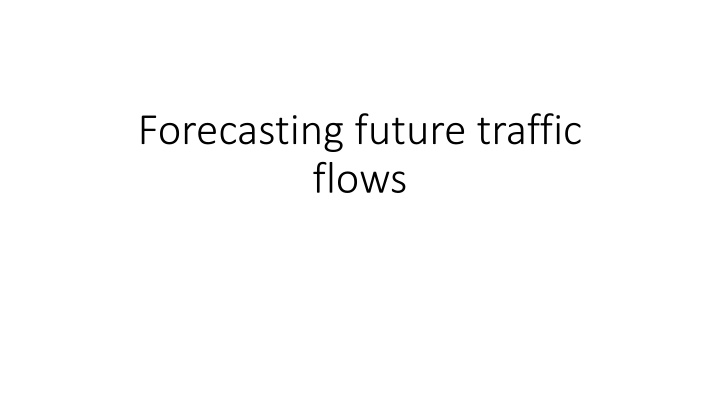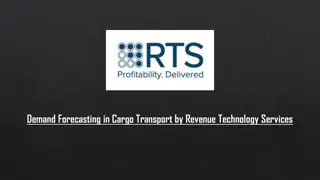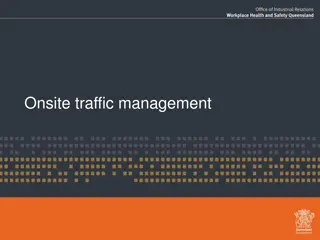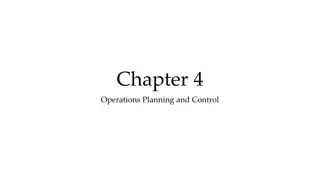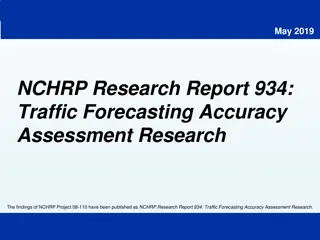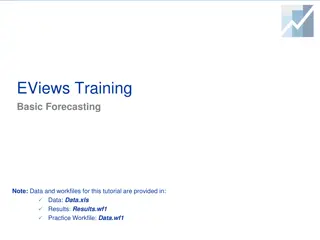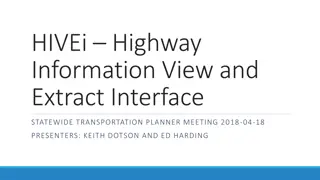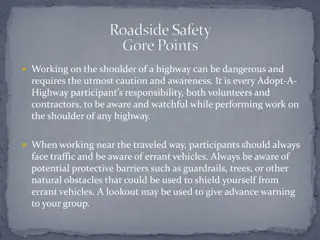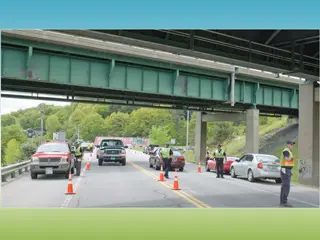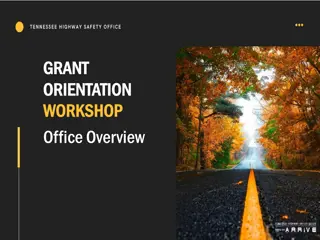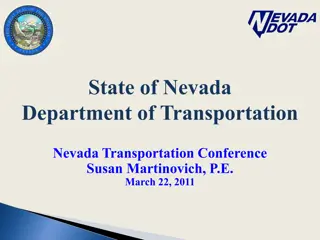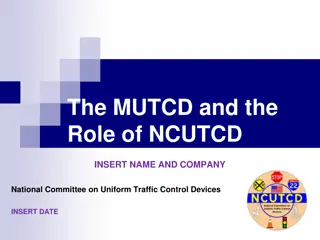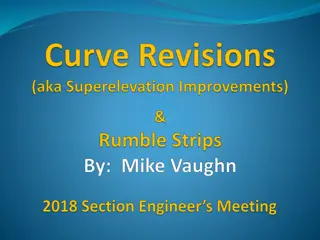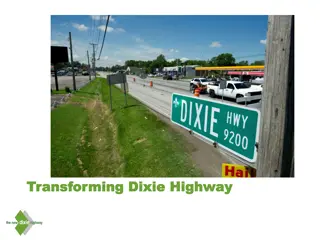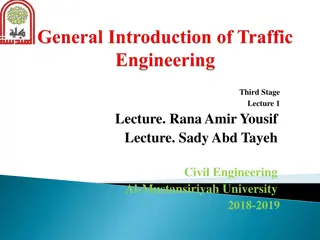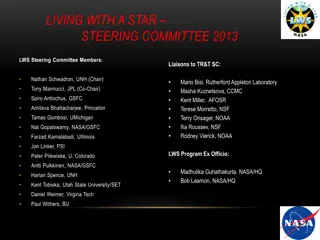Principles of Traffic Demand Analysis and Highway Demand Forecasting
Understanding traffic flows is crucial in designing highways and managing traffic effectively. Traffic demand analysis involves forecasting future traffic volumes, modeling demand, and determining the necessary infrastructure improvements. This analysis helps in estimating axle loadings, pavement thickness, lane requirements, and service levels to optimize highway projects. Highway demand analysis focuses on predicting travel behavior and demand for highway services through trip measurements from origin to destination points.
Download Presentation

Please find below an Image/Link to download the presentation.
The content on the website is provided AS IS for your information and personal use only. It may not be sold, licensed, or shared on other websites without obtaining consent from the author.If you encounter any issues during the download, it is possible that the publisher has removed the file from their server.
You are allowed to download the files provided on this website for personal or commercial use, subject to the condition that they are used lawfully. All files are the property of their respective owners.
The content on the website is provided AS IS for your information and personal use only. It may not be sold, licensed, or shared on other websites without obtaining consent from the author.
E N D
Presentation Transcript
Basic principles of traffic demand analysis Demand modelling Land-use models Trip generation Trip distribution Modal split Traffic assignment
Basic principles of traffic demand analysis Basic principles of traffic demand analysis If transport planners wish to modify a highway network either by constructing a new roadway or by instituting a programme of traffic management improvements, any justification for their proposal will require them to be able to formulate some forecast of future traffic volumes along the critical links.
In the construction of a new roadway, knowledge of traffic volumes along a given link enables the equivalent number of standard axle loadings over its life span to be estimated
This leads directly to the design of an allowable pavement thickness, and provides the basis for an appropriate geometric design for the road, leading to the selection of a sufficient number of standard width lanes in each direction to provide the desired level of service to the driver.
Highway demand analysis thus endeavours to explain travel behavior within the area under scrutiny and, on the basis of this understanding, to predict the demand for the highway project or system of highway services produced.
The prediction of highway demand requires a unit of measurement for travel behavior to be defined. This unit is termed trip and involves movement from a single origin to a single destination. The parameters utilized to detail
Principles of traffic demand analysis Knowledge of traffic volumes Equivalent number of standard axle loadings over its life span Design of allowable design life Selection of a sufficient number of standard width lanes in each direction Provide the desired level of service
What highway demand analysis does Explains travel behavior within an area Predict demand for highway project System of highway services proposed
The unit of measurement for travel behavior is called TRIP It is the movement from a single origin to a single destination
Parameters utilized to detail the nature and extent of trip Purpose Time of departure and arrival Mode employed Distance of origin from destination Route travelled
Within highway demand analysis, the justification for a trip is founded in economics and is based on what is termed utility derived from the trip. An individual will only make a trip if it makes economic sense to do so, that is, if the economic benefit or utility of making the trip is greater than the benefit accrued by not travelling, otherwise it makes sense to stay at home as travelling results in no economic benefit to the individual concerned
Utility defines the usefulness in economic terms of a given activity. Where two trips are open to an individual, the one with the greater utility will be undertaken. The utility of any trip usually results from the activity that take place at its destination. For example, workers travelling from the surburbs to the city centre by car, the basic utility of that trip is the economic activity that it makes possible, that is, the job done by the traveler for which he or she gets paid.
One must therefore assume that the payment received by a given worker exceeds the cost of making the trip (termed disutility), otherwise it would have no utility or economic basis. The cost need not necessarily be in money terms, but can also be the time taken or lost by the traveler while making the journey. If an individual can travel to his or her place of work in more than one way, say, for example, by either car or bus, he or she will use the mode of travel that costs the least amount, as this will allow the individual to maximize the net utility derived from the trip to the destination
Net utility is obtained by subtracting the cost of the trip from the utility generated by the economic activity performed at the traveler s destination
Demand modelling It requires that all parameters determining the level of activity within a highway network must first be identified and then quantified so that the results output from the model has an acceptable level of accuracy. One of the complicating factors in the modelling process is that, for a given trip emanating from a particular location, once a purpose has been established for making it, there are an enormous number of decisions relating to that trip, all of which must be considered and acted on simultaneously within the model
Decisions relating to trip Temporal decisions: once the decision has been made to make the journey, it still remains to be decided when to travel Decisions on journey destination: a specific journey must be selected for the trip, for example, a place of work, school or shopping district. Modal decisions: relates to what mode of transport the traveler intends to use, be it car, bus, train or slower modes such as cycling or walking Spatial decisions: focuses on the actual physical route taken from origin to final destination. The choice between potential routes is made on the basis of which has the shorter travel time
Avoidance of cumbersome modelling To avoid cumbersome modelling, simplification to the complex decision-making processes within it must be imposed. Within a basic highway model, the process of simplification can take the form of two stages 1. stratification of trips by purpose and time 2. use of separate models in series for estimating the number of trips made from a given geographical area under examination, the origin and destination of each, the mode of travel used and the route selected.
Stratification of trips It involves modelling the network in question for a specific time of the day, most often the morning peak hour and possibly, some critical off- peak period with trip purpose being stratified into work and non- work. For example, work-related trips are modelled during the morning peak hour (alternatively, it may be more appropriate to model all non- work trips at some designated time during the middle of the day)
Stratification models Trip generation model, estimating the number of trips made to and from a given segment of the study area Trip distribution model, estimating the origin and destination of each trip Modal choice model, estimating the form of travel for each trip Route assignment mode, predicting the route selected for each trip
The four models are used in series and are described as the basic travel demand model. The sequential structure of the traveler decisions constitute a considerable simplification of the actual decision process where all the decisions relating to the trip in question are considered simultaneously, and it provides a sequence of mathematical models of travel behavior capable of meaningful forecasting traffic demand. An overall model of this type may also require information relating to the prediction of future land uses within the study area, along with projections of the socio-economic profile of the inhabitants, to be input at the start of the modelling process
at the outset, the study area is divided into a number of geographical segments or zones The average set of travel characteristics for each zone is then determined, based on factors such as the population of the zone in question. This grouping removes the need to measure each inhabitant s utility for travel, a task that would in any case be virtually impossible to achieve from the modeler s perspective.
The ability of the model to predict future travel demand is based on the assumption that future travel patterns will resemble those of the past. Thus the model is initially constructed in order to predict to some reasonable degree of accuracy, present travel behavior within the study area under scrutiny. Information on present travel behavior within the area is analyzed to determine the meaningful regression coefficients for the independent variables that would predict the dependent variable under examination.
This process of calibration will generate an equation in which, for example, the existing population of a zone, multiplied by the appropriate coefficient, added to the average number of workers at present per household multiplied by its coefficient, will provide the number of work trips currently originating from the zone in question. Once the modeler is satisfied that the set of values generated by the process is realistic, the calibration stage can be completed and the prediction of trips originating from the zone in question at some point in the future can be estimated by changing the values of the independent variables based on future estimates from experts.
Land-use models The demand for movement or trip making is directly connected to the activities undertaken by people. These activities are reflected in both the distribution and type of land uses within a given area By utilizing relationships between the present day land uses and consequent movements in a given area, estimates of future movements given on land-use projections can be derived The derivation of relationships between land uses and people movements is thus fundamental to an effective transport planning process.
A land use model will estimate the future development for each of the zones within the study area, with estimate relating not only to predictions regarding the different land uses but also to those socio- economic variables that form the basic data for trip generation, the first of the four-stage sequential models Input by experienced land-use planners is essential to the success of this phase. The end product of the land-use forecasting process usually takes the form of a land-use paln where land-use stretching towards some agreed time horizon, usually between 5 and 25 years are agreed.
The actual numerical relationship between land use and movement information is derived using statistical/mathematical techniques. A regression analysis is employed to establish, for a given zone within the study area, the relationship between the vehicle trips produced by or attracted to it and characteristics derived both from the land- use study and demographic projections. This leads us directly to the first trip modelling stage.
Trip Generation Provides a measure of the rate at which trips both in and out of the zone in question are made. The predict the total number of trips produced by and attracted to its zone. Centres of residential development, where people live, generally produces the trip. The more dense the development and the greater the average household income is within a given zone, the more the trips produced by it.
Centres of economic activity, where people work, are the end points of these trips The greater the number of office, factory and shopping space existing within the zone, the more the journeys terminating within it. These trips are a two-way excursion with the return journey made some later stage during the day.
It is an innately difficult and complex task to predict when a trip would occur. This complexity arises from the different types of trips that can be undertaken by a car user during the course of the day (work, shopping, leisure etc.) The process of stratification attempts to simplify the process of predicting the number and type of trips made by a given zone. Trips are stratified by purpose, be it work, shopping or leisure. Different types of trips have different characteristics that result in them being more likely to occur at different times of the day
The peak time for the journey to work is generally in the early morning. Shopping are most likely during the early evening Stratification by time, termed temporal aggregation, can also be used, where trip generation models predict the number trips per unit time frame during any given day. An alternative simplification procedure can involve considering the trip behavior of an entire household of travelers rather than each individual trip maker within it Such an approach is justified by the homogeneous nature, in social and economic terms, of the members of a household within a given zone.
Variables governing rates at which trips are made From each zone within the study area: 1. distance of zone from the central business district/city centre area 2.Socio-economic characteristics of the zone population (per capita income, cars available per household) 3. intensity of land use (housing units per hectare, employees per square metre of office space)
The relationships between trips generated and the relevant variables are expressed as mathematical equations, generally expressed in linear form. ???= ?0+ ?1?1?+ ?2?2?+ + ????? Where: Tij = number of vehicle per trips per time period for trip I (work, non work) Z = characteristics value n for household j, based on factors such as the household income level and the number of cars available within it. = regression coefficient estimated from travel survey data relating to n
a typical equation obtained for a transportation study in the UK is T= 0+0.07xZ1 + 0.005xZ2 +0.95XZ3- 0.003Z4 Where: T = total number of trips per household per 24h Z1 = family size Z2 =total income of household Z3 cars per household Z4= housing density
